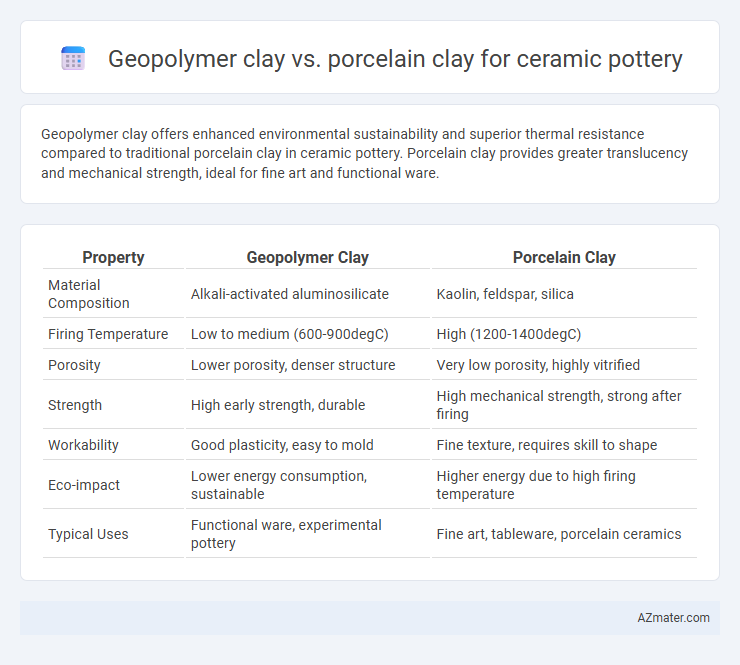Geopolymer clay offers enhanced environmental sustainability and superior thermal resistance compared to traditional porcelain clay in ceramic pottery. Porcelain clay provides greater translucency and mechanical strength, ideal for fine art and functional ware.
Table of Comparison
| Property | Geopolymer Clay | Porcelain Clay |
|---|---|---|
| Material Composition | Alkali-activated aluminosilicate | Kaolin, feldspar, silica |
| Firing Temperature | Low to medium (600-900degC) | High (1200-1400degC) |
| Porosity | Lower porosity, denser structure | Very low porosity, highly vitrified |
| Strength | High early strength, durable | High mechanical strength, strong after firing |
| Workability | Good plasticity, easy to mold | Fine texture, requires skill to shape |
| Eco-impact | Lower energy consumption, sustainable | Higher energy due to high firing temperature |
| Typical Uses | Functional ware, experimental pottery | Fine art, tableware, porcelain ceramics |
Introduction to Geopolymer and Porcelain Clays
Geopolymer clay is an innovative material made from aluminosilicate-rich industrial byproducts like fly ash and metakaolin, offering enhanced thermal resistance and environmental sustainability in ceramic applications. Porcelain clay, composed mainly of kaolin, feldspar, and quartz, is prized for its fine particle size, high plasticity, and translucency after firing, resulting in delicate, white, and strong pottery. The distinct chemical composition and firing properties of geopolymer and porcelain clays influence their suitability for different ceramic techniques and functional uses.
Composition and Chemical Structure
Geopolymer clay is composed mainly of aluminosilicate materials activated by alkaline solutions, forming a three-dimensional polymeric Si-O-Al network that offers high thermal stability and chemical resistance. Porcelain clay primarily consists of kaolin (a pure form of alumina silicate), feldspar, and quartz, creating a denser and vitrified structure with a high melting point after firing. The chemical structure of geopolymer clay features a synthetic amorphous network providing durability, while porcelain's naturally occurring crystalline phases contribute to its strength and translucency in ceramic pottery.
Workability and Forming Techniques
Geopolymer clay exhibits excellent plasticity and is highly adaptable to various forming techniques such as hand-building, slip casting, and mold pressing due to its fine particle size and chemical composition. Porcelain clay, known for its smooth texture and high vitrification, requires careful control during throwing and molding to prevent warping and cracking but offers superior strength and translucency after firing. The workability of geopolymer clay allows for faster setting and curing times, while porcelain demands precise moisture regulation and longer drying stages to maintain structural integrity.
Firing Temperature and Energy Consumption
Geopolymer clay typically fires at lower temperatures ranging from 600degC to 900degC, significantly reducing energy consumption compared to porcelain clay, which requires firing between 1200degC and 1400degC. The lower firing temperature of geopolymer clay not only conserves energy but also lowers production costs and reduces carbon emissions associated with high-temperature kilns. Porcelain's high firing temperature contributes to its strength and translucency but demands more fuel and extended kiln operation times, impacting overall sustainability.
Durability and Physical Properties
Geopolymer clay demonstrates superior durability compared to porcelain clay, exhibiting higher resistance to cracking and thermal shock due to its inorganic polymer network structure. Porcelain clay, while known for its fine, smooth texture and translucency after firing, is more brittle and prone to chipping under mechanical stress. The dense microstructure of geopolymer ceramics provides enhanced compressive strength and chemical resistance, making them ideal for applications requiring robust physical properties.
Environmental Impact and Sustainability
Geopolymer clay produces significantly lower carbon emissions compared to porcelain clay due to its reliance on industrial byproducts like fly ash and slag instead of kaolin and feldspar, reducing mining impacts. Its energy consumption during firing is generally lower, contributing to a smaller overall environmental footprint. Porcelain clay, while durable and valued for its aesthetic qualities, demands more intensive resource extraction and higher kiln temperatures, translating to increased greenhouse gas emissions and less sustainable production practices.
Cost Comparison and Accessibility
Geopolymer clay typically offers a cost-effective alternative to porcelain clay, driven by lower raw material expenses and reduced firing temperatures, making it accessible for budget-conscious potters. Porcelain clay, while more expensive due to its refined kaolin content and high firing requirements, provides superior translucency and durability preferred in fine ceramics. Accessibility-wise, geopolymer clay can be sourced from industrial byproducts and synthesized locally, whereas porcelain clay often requires specialized suppliers, limiting availability in certain regions.
Aesthetic Qualities and Finish
Geopolymer clay offers a matte, natural texture with an earth-toned palette that enhances rustic and contemporary ceramic pottery designs. Porcelain clay delivers a smooth, translucent finish with high whiteness and finesse, ideal for delicate, refined art pieces and fine tableware. The choice between these clays influences the aesthetic outcome, with geopolymer providing robustness and organic appeal, while porcelain enables crisp, elegant detailing and a glossy surface.
Applications in Modern Ceramic Pottery
Geopolymer clay offers superior thermal resistance and chemical durability, making it ideal for high-performance industrial ceramic pottery applications such as heat-resistant tiles and chemical containers. Porcelain clay, prized for its fine whiteness and translucency, is preferred in artistic and functional ceramics like dinnerware and decorative items, where aesthetic quality and smooth finish are paramount. The distinct mineral compositions and firing ranges of geopolymer and porcelain clays drive their specialized uses in modern ceramic pottery craftsmanship.
Choosing the Right Clay for Your Project
Geopolymer clay offers exceptional durability and heat resistance, making it ideal for functional pottery requiring strength and longevity, while porcelain clay provides a smooth, white finish favored for fine, delicate ceramics with a glass-like translucency. Key considerations include firing temperature, as porcelain typically requires higher kiln temperatures around 1300degC, whereas geopolymer clay can cure at lower temperatures or even room temperature, affecting production methods and energy costs. Selecting the right clay depends on project requirements such as aesthetic goals, mechanical properties, firing resources, and intended use, ensuring optimal performance and finish.

Infographic: Geopolymer clay vs Porcelain clay for Ceramic pottery
 azmater.com
azmater.com